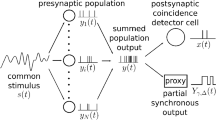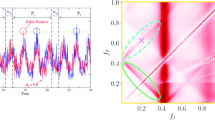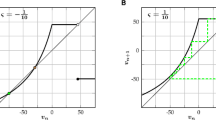Abstract
We consider a situation in which individual features of the input are represented in the neural system by different frequencies of periodic firings. Thus, if two of the features are presented concurrently, the input to the system will consist of a superposition of two periodic trains. In this paper we present an algorithm that is capable of extracting the individual features from the composite signal by separating the signal into periodic spike trains with different frequencies. We show that the algorithm can be implemented in a biophysically based excitatory-inhibitory network model. The frequency separation process works over a range of frequencies determined by time constants of the model’s intrinsic variables. It does not rely on a “resonance” phenomenon and is not tuned to a discrete set of frequencies. The frequency separation is still reliable when the timing of incoming spikes is noisy.







Similar content being viewed by others
References
Adrian, E.D. (1950). The electrical activity of the mammalian olfactory bulb. Electroencephalography and Clinical Neurophysiology, 2, 377–388.
Arieli, A., Shoham, D., Hildesheim, R., Grinvald, A. (1995). Coherent spatiotemporal patterns of ongoing activity revealed by real-time optical imaging coupled with single-unit recording in the cat visual cortex. Journal of Neurophysiology, 73, 2072–2093.
Bar-Gad, I., & Bergman, H. (2001). Stepping out of the box: information processing in the neural networks of the basal ganglia. Current Opinion in Neurobiology, 11, 689–695.
Bar-Gad, I., Havazelet, H.G., Goldberg, J.A., Ruppin, E., Bergman, H. (2000). Reinforcement driven dimensionality reduction—a model for information processing in the basal ganglia. Journal of Basic & Clinical Physiology & Pharmacology, 11, 305–320.
Bose, A., Manor, Y., Nadim, F. (2001). Bistable oscillations arising from synaptic depression. SIAM Journal of Applied Mathematics, 62, 706–727.
Christen, M., Kern, A., Nikitchenko, A., Steeb, W.-W., Stoop, R. (2004). Fast spike pattern detection using the correlation integral. Physical Review E, 70, 011901.
Dayhoff, J.E., & Gerstein, G.L. (1983). Favored patterns in spike trains. I. Detection. Journal of Neurophysiology, 49, 1334–1348.
Ecker, A.S., Berens, P., Keliris, G.A., Bethge, M., Logothetis, N., Tolias, A. (2010). Decorrelated neuronal firing in cortical microcircuits. Science, 327, 584–587.
Green, J.D., & Arduini, A. (1954). Hippocampal activity in arousal. Journal of Neurophysiology, 17, 533–557.
Hodgkin, A., & Huxley, A. (1952). A quantitative description of membrane current and its application to conduction and excitation in nerve. Journal of Physiology, 117, 500–544.
Kazanovich, Ya., & Borisyuk, R. (2006). An oscillatory neural model of multiple object tracking. Neural Computation, 18, 1413–1440.
Kuramoto, Y. (1991). Collective synchronization of pulse coupled oscillators and excitable units. Physica D, 50, 15–30.
Landolfa, M.A., & Miller, J.P. (1995). Stimulus-response properties of cricket cercal filiform receptors. Journal of Comparative Physiology, 177, 745–757.
Matveev, V., Bose, A., Nadim, F. (2007). Capturing the bursting dynamics of a two-cell inhibitory network using a one-dimensional map. Journal of Computational Neuroscience, 23, 169–187.
Niebur, E., Hsiao, S.S., Johnson, K.O. (2002). Synchrony: a neuronal mechanism for attentional selection? Current Opinion in Neurobiology, 12, 190–194.
Renart, A., de la Rocha, J., Bartho, P., Hollender, L., Parga, N., Reyes, A., Harris, K. (2010). The asynchronous state in cortical circuits. Science, 327, 587–590.
Rose, J.E., Brugge, J.F., Anderson, D.J., Hind, J.E. (1967). Phase-locked response to low-frequency tones in single auditory nerve fibers of the squirrel monkey. Journal of Neurophysiology, 30, 769–793.
Terman, D., Rubin, J.E., Yew, A.C., Wilson, C.J. (2002). Activity patterns in a model for the subthalamopallidal network of the basal ganglia. Journal of Neuroscience, 22, 2963–2976.
Taube, J.S., Muller, R.U., Ranck, J.B. Jr. (1990). Head-direction cells recorded from the postsubiculum in freely moving rats. I. Description and quantitative analysis. Journal of Neuroscience, 10, 420–435.
Tetko, I.V., & Villa, A.E.P. (2001). A pattern grouping algorithm for analysis of spatiotemporal patterns in neuronal spike trains. 1. Detection of repeated patterns. Journal of Neuroscience Methods, 105, 1–14.
Tetzlaff, T., Helias, M., Einevoll, G., Diesmann, M. (2010). Decorrelation of low-frequency neural activity. BMC Neuroscience, 11, Suppl. 1, 011.
Torras, C. (1986). Neural network model with rhythm assimilation capacity. IEEE Transactions on Systems, Man and Cybernetics, 16, 680–693.
Acknowledgements
This work was supported by the Mathematical Biosciences Institute and the National Science Foundation under grant DMS 0931642, NSF grant DMS-1022945 (AB), NSF CAREER Award DMS-0956057 (JB), Alfred P. Sloan Research Foundation Fellowship (JB).
Author information
Authors and Affiliations
Corresponding author
Additional information
Action Editor: Carson C. Chow
Appendix
Appendix
Equations for an I cell
The intrinsic current I ion consists of the leak, sodium, and potassium currents, and the bias current I:
where
The parameters are given in Table 1.
Equations for an E cell
The intrinsic current I ion consists of the leak, sodium, and potassium currents, and the T-type current—outward current activated by hyperpolarization:
where
External input to the E cell is equal to zero (I input = 0). Parameter values are given in Table 1.
Rights and permissions
About this article
Cite this article
Borisyuk, A., Best, J. & Terman, D. Frequency separation by an excitatory-inhibitory network. J Comput Neurosci 34, 231–243 (2013). https://doi.org/10.1007/s10827-012-0417-5
Received:
Revised:
Accepted:
Published:
Issue Date:
DOI: https://doi.org/10.1007/s10827-012-0417-5




